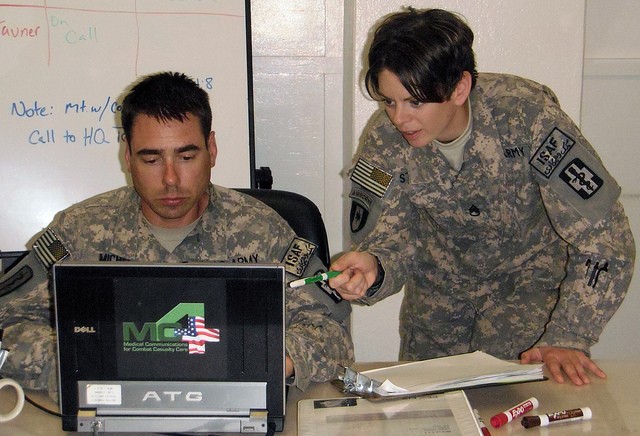
Swapping three systems and folders stuffed with paper forms for one laptop and a few forms was too good of an idea to pass up for LTC Patricia Ten Haaf, commander of the 452nd Combat Support Hospital (CSH). After all, leading an eight-bed medical treatment facility at Forward Operating Base Salerno in Afghanistan had enough challenges.
The CSH dealt with the constant flux of patients suffering from traumatic injuries resulting from improvised explosive devices, as well as sports-related injuries. To LTC Ten Haaf, continuing a cumbersome process for documenting patient care was like adding fuel to the fire.
"Our business practices consisted of three separate systems," LTC Ten Haaf said. "We used AHLTA-T for outpatient notes and TC2 for inpatient notes. We also used paper charts to augment both programs. The various systems often led to duplicate data entry and it wasn't easy to locate historical information. With notes in different locations, a key piece of information could be missed while treating a patient."
To drive change, LTC Ten Haaf began a Lean Six Sigma (LSS) project. It began following a major software upgrade to their medical recording system, <a href="http://www.mc4.army.mil">Medical Communications for Combat Casualty Care (MC4)</a>.
In the summer of 2009, MC4 staff delivered improved functionality to the EMR system that allowed medical staff to chart a limited amount of inpatient data into the once outpatient-only application-AHLTA-T. This provided the opening LTC Ten Haaf needed to improve EMR efficiencies and became the focus of her LSS project.
The goal was to use one system to save time, reduce waste, improve patient safety and facilitate better care throughout the patient continuum. Specific measures of success included the reduction in paper, steps to admit a patient, time to admit a patient and amount of areas providers must look for information.
Everyone got involved. Nurses, doctors and ancillary personnel met within their respective areas. They discussed workflow processes, created templates, developed best business practices and generated standard operating procedures (SOPs).
"We realized that in order to successfully study all of the processes throughout the hospital, everyone had to be involved," LTC Ten Haaf said. "The change would affect all areas of patient care. It was important that every section of the hospital be responsible to study their daily processes to uncover areas for change."
Empowering champions for each section of the hospital proved fruitful. Providers in the ER cut their documentation requirements by 50 percent, no longer charting an electronic note and then duplicating the information on a paper trauma form.
Nurses created 22 digital templates to work with the upgraded software, reducing paper forms from nine per patient to two. This played a huge role in reducing the steps to admit a patient from 39 to 23. The duration for each admission also reduced from an average of 66.66 minutes to 58.11 minutes.
"The reduction in time is actually misleading," LTC Ten Haaf said. "Each patient is unique; therefore, each nurse customizes the admission process accordingly. The significance with this effort is that fewer required tasks reduce the potential for omissions and errors."
While most sections could migrate from the inpatient software application, TC2, pharmacy staff still had to use it.
"Since AHLTA-T could not be used for medication administration, the nurses chose to continue using paper forms for this process," LTC Ten Haaf said. "Clinical teams ordered medications via AHLTA-T and the fulfillment occurred behind the scenes with TC2. It is the one of the few instances of medical documentation to remain on paper forms."
Once the LSS project proved its worth, leadership approved the process changeover. The implementation of the new AHLTA-T system occurred slowly throughout the hospital, one patient at a time.
The 452nd CSH completed the migration project in November, exceeding their December deadline. Unit leadership issued policies to solidify the new processes and developed an educational program with training materials to help new personnel utilize the EMR system.
The policies, SOPs and best business practices provided a smooth transition for the 344th CSH, who took over for the unit in April 2010. They learned about the study and improvements, and decided to adopt the new business practice.
"Feedback from the nursing staff confirmed that the use of AHLTA-T allows for faster patient charting, along with legible and organized notes," said MAJ Lorna Hosang-Davidson, deputy commander for nursing with the 344th CSH. "Utilization of an electronic system, coupled with the reduction of paper documentation, also helps to guard the safety of the information."
Utilizing the limited inpatient functionality of AHLTA-T on the battlefield may not be the ideal solution for all users. Facilities must adhere to the theater policies regarding inpatient and outpatient documentation via MC4 systems. The migration to AHLTA-T at FOB Salerno also allowed MC4's technical personnel to identify functional challenges of the application to software developers for resolution. Armed with a working knowledge of the EMR system and facility business practices, medical personnel at FOB Salerno have the opportunity to improve processes and procedures to enhance the documentation efforts throughout treatment facilities.
"We're currently developing a template to decrease the time to chart patient information in the intensive care unit," MAJ Hosang-Davidson said. "Team members mentioned that they would like to see enhancements made to the templates themselves, such as decreasing the backspacing of information while free texting notes. We want the team to drive the changes and enhancements so that system satisfies their needs while capturing the critical patient data."
The medical team for the 344th CSH continues to refine the documentation efforts at FOB Salerno, building upon the efforts of the 452nd CSH. The new wave of process evaluation further streamlines the charting efforts, leading to additional improvements throughout the facility.

Social Sharing